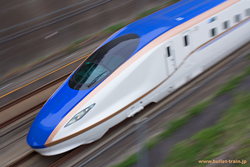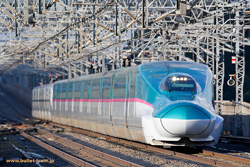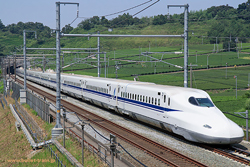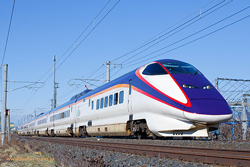Kids Web Japan
Web Japan > Kids Web Japan > Explore Japan > Economy > Trade Surplus
Explore Japan
Economy and Industry
Q. How fast do Shinkansen trains go? Where are their routes?

The Hokuriku Shinkansen runs at a maximum speed of 260 kilometers (162 miles) per hour.
©Bullet-train.jp
A.
During regular operation, Shinkansen, or bullet trains, can reach speeds of up to 320 kilometers (200 miles) per hour. There are plans to raise this limit to around 360 kph (224 mph) in the near future. The Shinkansen was inaugurated in 1964, the year of the Tokyo Olympic Games. It operated for 515 kilometers (320 miles) between Tokyo and Osaka via Nagoya. In 1975 the line was extended southwest to Fukuoka, Kyushu, more than doubling the total length to 1,069 kilometers (663 miles). In 2016, the line linked Kagoshima, in southern Japan, to Hokkaido, in northern Japan.

The Tohoku Shinkansen, which connects Tokyo and Shin-Aomori, runs through the Tohoku region in about three hours.
©Bullet-train.jp
Tohoku Shinkansen, which opened between Omiya and Morioka in 1982, was extended gradually and finally connected full distance from Tokyo to Shin Aomori in 2010. In 2016, it was connected with the Hokkaido Shinkansen via an under-the-sea tunnel, which has made it possible to ride the shinkansen from Tokyo to Hakodate in Hokkaido for about 825 kilometers (about 512miles). The Hokkaido Shinkansen will be extended to further north, reaching Sapporo (about 210 kilometers/130 miles) in 2030.
The shinkansen was also extended from Tokyo on the Pacific Ocean side to the cities on the Japan Sea side. In addition to Akita, Yamagata and Niigata stations, Kanazawa Station opened in 2015 connecting Tokyo-Kanazawa (about 450 kilometers/280 miles) in 2 and half hours.
In March 2004 the Kyushu Shinkansen began operating on a 127.6-kilometer (79-mile) route between Kagoshima-Chuo Station and Shin-Yatsushiro Station. The route was expanded from Shin-Yatsushiro to Hakata in March 2011, enabling a direct connection to Sanyo Shinkansen line.
The Shinkansen was designed to provide a high-speed means of transporting large numbers of people over long distances. They proved popular not only among business workers but also tourists.
In recent years, a growing number of people have begun using the Shinkansen to commute to work. To meet the demands for more seats, "double-decker" cars have been introduced.
Bullet trains are operated with the most advanced technology available to guarantee efficiency and safety. There are systems to automatically and centrally control the trains' speed and the distance between trains, and the trains can be stopped or slowed in emergencies. In 2012, a new model, N700A, made its debut, equipped with an automatic operating mechanism and a new type of brakes.
 |
 |
| The trains of the Tokaido-Sanyo Shinkansen are designated "Nozomi," "Hikari," and "Kodama" according to their speed, from fastest to slowest. ©Bullet-train.jp |
The colors and logos of the Tohoku-Yamagata Shinkansen trains were updated in 2014. ©Bullet-train.jp |